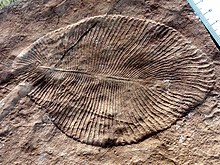Proarticulata
| Proarticulata | |
|---|---|

| |
| Fossil of Dickinsonia costata | |

| |
| Fossil of Spriggina | |
| Scientific classification | |
| Domain: | Eukaryota |
| Kingdom: | Animalia |
| Stem group: | Bilateria |
| Phylum: | †Proarticulata Fedonkin, 1985 |
| Class / Family | |
For more taxa, see text | |
Proarticulata is a proposed
Due to their simplistic morphology, their affinities and mode of life are subject to debate. They are almost universally considered to be
Morphology

Vendiamorpha
The body is completely segmented, with all isomers curved towards the posterior, and the first isomer is normally much larger than the rest. The first two isomers at the anterior dorsal end are partly fused. (e.g., Vendia, Paravendia and Karakhtia).[6][13][14][15]
Cephalozoa
These proarticulatans are incompletely segmented, as the anterior zone is free of isomers, often making a "hairband" like appearance (example cephalozoans include


In Cephalonega stepanovi and Tamga hamulifera the zone containing the isomers is encircled by a peripheral, undivided zone.[16] The Cephalonega's isomers are connected to each other, forming a body resembling a rubber raft; the Tamga's isomers are separated from each other, and do not touch.
In Lossinia, the center undivided region has no visible isomers, instead having the lobe-like isomers emanate from the periphery of the undivided region as "transverse articulations."[16]
Dipleurozoa
The dipleurozoan body is subradial, divided by isomers entirely (e.g., Dickinsonia and Phyllozoon). Dickinsonia juveniles show undivided anterior areas but these regions were reduced in the course of ontogeny, and in the adult stages Dickinsonia-like proarticulates changed so radically that they became almost indistinguishable from isomers.[13][16][18]
List of Proarticulata
Body fossils
- Armillifera Fedonkin, 1980[19]
- A. parva Fedonkin, 1980
- A. ivantsovi Fedonkin, 2002
- A. fedonkini Ivantsov, 2001
- Cephalonega Ivantsov et al., 2019[21]
- Chondroplon Wade, 1971 (possible =Dickinsonia)
- C. bilobatum Wade, 1971
- C. singularis Ivantsov, 2004
- Dickinsonia Sprigg, 1947
- D. costata Sprigg, 1947
- D. menneri Keller 1976[16] (=Vendomia menneri Keller 1976[22])
- D. tenuis Glaessner & Wade, 1966
- I. rugulosa Ivantsov, 2007
- Karakhtia Ivantsov, 2004
- K. nessovi Ivantsov, 2004
- L. lissetskii Ivantsov, 2007
- Marywadea Glaessner, 1976
- M. ovata Glaessner & Wade, 1966
- Ovatoscutum Glaessner & Wade, 1966
- O. concentricum Glaessner & Wade, 1966
- Paravendia Ivantsov, 2004[6][13]
- P. janae Ivantsov, 2001 (=Vendia janae Ivantsov, 2001)
- Podolimirus Fedonkin, 1983 (=Valdainia Fedonkin, 1983)[23]
- P. mirus Fedonkin, 1983 (Valdainia plumosa Fedonkin, 1983)
- Praecambridium Glaessner & Wade, 1966
- P. siggilum Glaessner & Wade, 1966
- Spriggina Glaessner, 1958
- S. floundersi Glaessner, 1958
- Tamga Ivantsov, 2007[16]
- T. hamulifera Ivantsov, 2007
- V. sokolovi Keller, 1969
- V. rachiata Ivantsov, 2004
- ? Windermeria Narbonne, 1994
- W. aitkeni Narbonne, 1994[24]
- Y. waggoneri Ivantsov, 1999
Trace fossils
- E. axiferus Ivantsov, 2002.
- E. waggoneris Ivantsov, 2011. This is a trace of Yorgia waggoneri
- E. costatus Ivantsov, 2011. This is a trace of Dickinsonia costata
- Phyllozoon Jenkins & Gehling, 1978
- P. hanseni Jenkins & Gehling, 1978
See also
References
- .
- S2CID 134213721.
- ^ Fedonkin MA (1985). "Systematic Description of Vendian Metazoa". In Sokolov BS, Iwanowski AB (eds.). Vendian System: Historical–Geological and Paleontological Foundation. Vol. 1: Paleontology. Moscow: Nauka. pp. 70–106.
- S2CID 55178329.
- ^ S2CID 203853224.
- ^ a b c d e f g Ivantsov, A.Yu. (2001). "Vendia and other precambrian "Arthropods"". Paleontological Journal. 35 (4): 335–343.
- ^ a b c Ivantsov, A.Yu. (1999). "A new Dickinsoniid from the upper Vendian of the White Sea Winter Coast (Russia, Arkhangelsk region)". Paleontological Journal. 33 (3): 233–241.
- PMID 29105292.
- .
- S2CID 203853224.
- PMID 24715452.
- PMID 29319110.
- ^ a b c d e f Ivantsov, A.Yu. (2004). "New Proarticulata from the Vendian of the Arkhangel'sk Region" (PDF). Paleontological Journal. 38 (3): 247–253. Archived from the original (PDF) on 2007-09-27.
- ^ Ivantsov, A.Yu.; Malakhovskaya, Y.E.; Serezhnikova, E.A. (2004). "Some problematic fossils from the Vendian of the south-eastern White Sea region" (PDF). Paleontological Journal. 38 (1): 1–9. Archived from the original (PDF) on 2007-07-04.
- ^ a b c Ivantsov, A.Yu. (2004). Vendian animals in the phylum Proarticulata (PDF). The Rise and Fall of the Vendian Biota. Prato, Italy. p. 52. IGSP Project 493.
- ^ a b c d e f g h i j
Ivantsov, A.Yu. (April 2007). "Small Vendian transversely articulated fossils". Paleontological Journal. 41 (2): 113–122. S2CID 86636748.
- ^ illustration (c) Stanton F. Fink
- ^ a b Ivantsov, A.Yu.; Malakhovskaya, Y.E. (2002). "Giant traces of Vendian animals" (PDF). Doklady Earth Sciences. 385 (6): 618–622. Archived from the original (PDF) on 2007-07-04.
- S2CID 86523806.
- S2CID 85352552.
- S2CID 203853224.
- ^ a b Keller BM, Fedonkin MA (1976). "New Records of Fossils in the Valdaian Group of the Precambrian on the Syuz'ma River" (PDF). Izvestiya Akademii Nauk SSR. Seriya Geologicheskaya (in Russian). 3: 38–44. Archived from the original (PDF) on 2007-09-27.
- ^ Dzik, J.; Martyshyn, A. (2015). "Taphonomy of the Ediacaran Podolimirus and associated dipleurozoans from the Vendian of Ukraine". Precambrian Research. 269: 139–146. .
- S2CID 133215767.
- S2CID 128741869.
External links
- Database of Ediacaran Biota Advent of Complex Life







